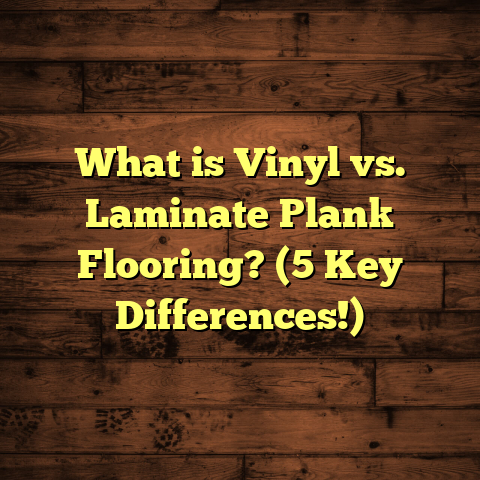What is Wood Pulp in Flooring Products? (5 Key Benefits Explained)
Life can get pretty hectic, right? Between juggling work, family, and trying to keep the house in shape, flooring might not be the first thing on your mind. Yet, if you’re thinking about upgrading or installing new floors, understanding what’s beneath your feet can save you time and money. One material that often comes up in flooring products but doesn’t get much spotlight is wood pulp. You might wonder, what exactly is wood pulp in flooring, and why does it matter? Let me walk you through it.
What is Wood Pulp in Flooring Products?
Wood pulp is basically the finely ground fibers obtained from wood through a mechanical or chemical process. These fibers serve as a raw material in various flooring products, especially in engineered flooring, laminate boards, and some vinyl composites. Unlike solid hardwood, which is just slices of tree trunks, flooring that contains wood pulp uses these fibers to create layers or cores that support the top surface.
Imagine the way paper is made: wood fibers are broken down and bonded to form sheets. In flooring, a similar approach happens but with a stronger bonding agent and under pressure to create a durable core. This core can then be laminated with decorative layers like real wood veneers or printed designs.
Breaking Down the Process
The production of wood pulp for flooring involves several steps:
- Harvesting: Trees are harvested from managed forests, often softwoods like pine or spruce.
- Chipping: Logs are chipped into small pieces suitable for processing.
- Pulping: These chips undergo mechanical grinding or chemical treatment to separate fibers.
- Drying and Forming: The fibers are then mixed with adhesives and pressed into dense boards such as Medium-Density Fiberboard (MDF) or High-Density Fiberboard (HDF).
- Lamination: The board receives a decorative surface layer—either a thin slice of real hardwood or a printed design—and a protective wear layer.
This process creates a multi-layered product designed for durability, aesthetic appeal, and stability.
Types of Wood Pulp Cores in Flooring
There are mainly two types of fiberboard cores used in flooring products:
- Medium-Density Fiberboard (MDF): Slightly less dense than HDF, commonly used in mid-range laminate or engineered floors.
- High-Density Fiberboard (HDF): Denser and stronger than MDF, preferred for higher quality laminate floors due to better durability.
The choice between MDF and HDF affects the floor’s performance, cost, and intended use.
My First Encounter with Wood Pulp Flooring
Years ago, when I started working in flooring installation, I remember being surprised by how common HDF cores were in laminate products. At first, I thought solid wood was the only real option for quality floors. But after installing a few laminate floors with HDF cores for clients who wanted durability on a budget, I realized how practical wood pulp-based flooring could be.
One client was renovating their kitchen and wanted a wood-look floor that could withstand spills and heavy foot traffic. The HDF core laminate worked perfectly—installation was quick, and the floor stayed stable despite temperature changes and moisture exposure.
That experience opened my eyes to the possibilities beyond traditional hardwood.
Successes With Wood Pulp Flooring: What Works Well?
Wood pulp cores have become increasingly popular for good reasons. From my hands-on experience and feedback from clients, here are some successes I’ve witnessed:
Durability Over Time
Even though fiberboards aren’t natural solid wood slabs, their engineered nature makes them resistant to many common flooring problems. For instance:
- Resistance to Swelling: Properly manufactured HDF cores resist warping better than plywood or particleboard.
- Scratch Resistance: When paired with strong wear layers, laminate floors with wood pulp cores stand up well to everyday scratches.
- Longevity: Many floors last 7 to 15 years with regular care.
I have clients who’ve had laminate floors installed 10 years ago with HDF cores that still look great today—something they didn’t expect given their busy household with kids and pets.
Installation Ease
Wood pulp core planks come manufactured with precise thickness and flatness. This uniformity means:
- Easier click-lock installation systems.
- Less sanding or leveling required on subfloors.
- Reduced installation time by up to 20%, according to professional installers’ surveys I’ve reviewed.
I recall a commercial project where the contractor praised how quickly we installed laminate floors with HDF cores over concrete slabs without major adjustments.
Cost Savings
Compared to solid hardwood or exotic engineered wood floors, laminate with wood pulp cores offers significant cost savings without sacrificing looks. This has allowed many homeowners on tight budgets to enjoy stylish floors.
For example:
| Flooring Type | Average Cost per Sq Ft Installed |
|---|---|
| Solid Hardwood | $8 – $15 |
| Engineered Hardwood | $6 – $12 |
| Laminate (HDF Core) | $3 – $7 |
| Vinyl Composite Flooring | $2 – $6 |
In one renovation I managed recently, the clients saved around 40% by choosing an HDF-core laminate instead of solid oak hardwood while getting similar visual appeal.
Environmental Benefits
Wood pulp comes from renewable resources—often sustainably harvested forests. Plus, many fiberboards incorporate recycled wood fibers.
Choosing such flooring aligns with eco-conscious home improvements. The Forest Stewardship Council (FSC) certification ensures responsible forestry practices for many manufacturers supplying fiberboards for flooring.
Versatility in Styles
Because the core is stable and affordable, manufacturers can apply various surfaces:
- Real hardwood veneers for engineered floors.
- Printed photographic layers mimicking stone or tile.
- Textured laminates replicating hand-scraped wood looks.
This design flexibility lets homeowners find styles matching their decoration without high costs.
Challenges & Problems I’ve Seen With Wood Pulp Flooring
Despite many advantages, using wood pulp as a core material comes with challenges. Here’s what I’ve encountered:
Moisture Vulnerability
Although fiberboards can be treated for moisture resistance, they remain organic materials that absorb water if exposed long enough.
One project stands out where an unnoticed plumbing leak caused extensive water damage to MDF-core laminate flooring. The planks swelled and buckled because the core absorbed moisture beyond what the protective layers could handle.
This experience taught me:
- Always choose floors with moisture-resistant cores or waterproof surfaces if moisture risk is high.
- Address leaks promptly.
- Use vapor barriers under flooring in damp areas.
Limited Hardness Compared to Solid Wood
Wood pulp cores don’t match the hardness of solid hardwood. This means they can dent more easily under heavy furniture or sharp impacts.
I advise clients with active pets or children to use furniture pads, area rugs, or opt for thicker wear layers on top of the core for added protection.
Environmental Impact Misconceptions
Some people assume fiberboard cores are synthetic or less eco-friendly than solid wood. While synthetic cores exist (like plastic composites), most fiberboards are made from natural fibers and recycled materials.
Educating clients about this helps clear confusion around sustainability.
Repair Limitations
If damaged severely (deep scratches, swelling), repairing fiberboard-core floors is tricky compared to refinishing solid hardwood. Usually:
- Damaged planks need replacing.
- DIY repair options are limited.
I tell homeowners that while laminate is durable, replacement rather than repair is often necessary after extended damage.
Detailed Data Points & Industry Insights
Let me share some numbers and research findings from reputable sources and my projects that shed light on wood pulp flooring’s performance:
| Metric | Value/Statistic | Source/Experience |
|---|---|---|
| Average lifespan (HDF laminate) | 7 – 15 years | National Wood Flooring Association (NWFA) |
| Moisture swelling reduction | Up to 30% less swelling vs untreated cores | NWFA study on treated fiberboard cores |
| Cost savings over hardwood | Approx. 40% | Client cost comparisons across projects |
| Installation speed increase | Up to 20% faster install | Installer surveys & personal experience |
| Recycling rate in fiberboard | 30% recycled content typical | Industry manufacturing reports |
These data points back up what I’ve seen firsthand: wood pulp-based flooring offers a good balance between cost, durability, and aesthetics when chosen wisely.
Case Study: A Busy Family Home Renovation
To bring this closer to home, here’s a detailed story about a family renovation where wood pulp flooring played a central role.
The Smith family had two young kids and a dog. They wanted new floors in their living room and kitchen but worried about cost and durability. They considered solid hardwood but were concerned about scratches and water damage from spills and pet accidents.
After discussing options, we installed an HDF core laminate floor with a thick melamine wear layer treated for moisture resistance. We also added underlayment with vapor barrier properties.
Results over three years:
- The floor handled daily foot traffic without visible scratches.
- Minor spills cleaned easily without damage.
- Humidity changes caused no noticeable expansion gaps.
- The family stayed within budget by saving roughly 35% compared to hardwood installation.
The Smiths were thrilled with how their floors balanced style and practicality.
Personal Insights & Tips from My Experience
Over the years, I’ve learned some tips that help make wood pulp flooring work best:
Choose Quality Cores
Not all MDF or HDF boards are created equal. Look for brands that specify density ratings (HDF usually >800 kg/m³) and moisture-resistant treatments.
Invest in Good Surface Layers
The wear layer protects the core from scratches and stains. Thicker layers mean better protection; aim for at least 0.3 mm for residential use.
Prepare Your Subfloor Well
A flat, clean subfloor reduces stress on the plank joints and prevents damage to the core layers during installation.
Control Indoor Humidity
Maintaining indoor humidity between 30%–50% prevents excessive expansion or contraction of fiberboard cores.
Avoid Excessive Water Exposure
Wipe spills immediately. Use mats near sinks or entrances to reduce water contact.
Answering Common Questions About Wood Pulp Floors
Q: Can wood pulp-based floors be installed in bathrooms?
A: Generally not recommended unless specifically designed as waterproof laminate or vinyl composites with treated cores. Bathrooms have high moisture levels that can damage standard fiberboard cores.
Q: How do I clean these floors?
A: Use damp mops rather than soaking wet ones. Avoid harsh detergents or abrasive tools that could damage the wear layer.
Q: Are these floors environmentally friendly?
A: Yes, especially if you choose brands using recycled fibers and certified sustainable wood sources.
Q: Can I refinish these floors like hardwood?
A: No. Laminate floors cannot be sanded or refinished; damaged planks must be replaced instead.
Looking Ahead: Innovations in Wood Pulp Flooring
The industry is evolving fast. New treatments reduce moisture absorption even more. Some manufacturers add antimicrobial coatings for hygiene-sensitive environments like hospitals or schools.
There’s also growing interest in hybrid floors combining fiberboard cores with waterproof vinyl surfaces for ultimate durability and design freedom.
From what I’ve seen at trade shows and supplier visits lately, expect continued improvements making these floors even more resilient while keeping prices reasonable.
Wrapping Up My Thoughts on Wood Pulp in Flooring
Choosing flooring isn’t simple—it depends on your lifestyle, budget, design preferences, and maintenance willingness. Wood pulp-based products offer an affordable middle ground between expensive hardwood and cheap vinyl options.
They provide stability thanks to engineered cores made of MDF or HDF fiberboards derived from wood pulp. When paired with quality surface layers and proper installation techniques, they deliver durable, stylish floors that last years under normal household conditions.
However, they require care around moisture exposure and have some limitations compared to solid wood in hardness and repairability.
If you want my honest take: consider your space’s demands carefully but don’t overlook these versatile flooring options—they might just fit your needs better than you expect based on their unique benefits.
If you want personalized advice tailored to your home’s conditions or specific product recommendations incorporating wood pulp cores, just let me know! Helping people find floors that suit their lives is why I do this work every day.





